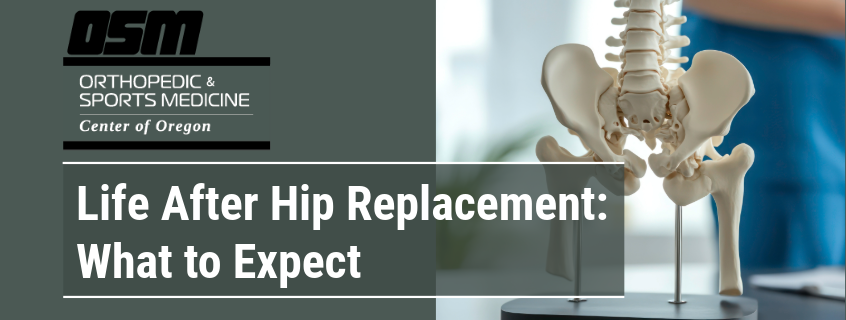Life After Hip Replacement: What to Expect
Article featured on Orthopaedic Associates
Hip replacement surgery is a cutting-edge procedure that helps individuals regain mobility that has been limited due to chronic hip pain. It includes replacing the damaged portion of the hip joint with a new, working prosthesis.
After a hip replacement is the recovery period. During this time, hip replacement patients should follow their orthopedic surgeon’s instructions and post-operative physical therapy and rehabilitation program.
If you are curious about how long it will take before you can return to your daily activities, keep reading. In this article, we will talk about what to expect after a hip replacement and where you can go in Westlake and Avon, OH for top-notch orthopedic services.
Rehabilitation After a Hip Replacement
After the surgery, it is essential to follow a carefully planned recovery process to ensure a successful outcome. One crucial aspect of this process is gradually returning to daily activities.
It is essential to start slowly and gradually increase your activity level. Your healthcare team, including your orthopedic surgeon and physical therapist, will provide specific guidelines based on your individual needs and how quickly you progress through the stages of recovery.
Immediate and Early Rehabilitation Phase
Once you are discharged from the hospital, you will soon begin an outpatient physical therapy program. The early rehabilitation phase usually lasts for the first few weeks after a hip replacement.
Below are some of the things you can expect during this time:
1. Pain Management
Managing post-operative pain through a combination of medication and ice therapy is important after a hip replacement. Pain should be managed for a comfortable recovery.
2. Physical Activity
Being sedentary can result in stiffness and delayed recovery. Sitting down for more than 45 minutes at a time is also discouraged. Patients are advised to get up and keep moving after a hip replacement, which also boosts circulation and healing. At this point, walking can still be aided by assistive devices such as a cane or walker.
However, too much activity can also increase pain and swelling. It’s best to follow the advice of your orthopedic care team.
3. Range of Motion and Strengthening Exercises
Performing gentle exercises improves hip joint mobility and flexibility. Hip replacement patients may start with ankle pumps and other leg exercises, such as calf and toe raises.
Also important are exercises aimed at strengthening the muscles around the hip joint, from the core muscles to the hamstrings. These exercises may include hip abduction and hip adduction exercises and straight leg raises.
4. Walking and Weight-Bearing Activities
Gradually increase weight-bearing activities, starting with assisted walking using crutches or a walker, and progress towards walking independently.
5. Balance and Stability Training
Practicing exercises improves balance and stability to prevent falls and regain confidence in daily activities.
Intermediate Rehabilitation Phase
This stage of recovery brings you closer to making a complete recovery from a hip replacement. Some of the things you can expect are the following:
- Advanced Strengthening Exercises – More challenging exercises to further improve strength and stability.
- Cardiovascular Conditioning – Low-impact cardiovascular exercises like stationary biking or swimming to improve endurance.
- Functional Activities – Practicing activities that simulate daily tasks, like stair climbing and bending down.
- Gait Training – Refining walking patterns and stride length.
In the advanced stages of rehabilitation, patients are ready to undergo sports-specific training or training specific to recreational activities until they can gradually return to their specific activity.
When Can I Return to Daily Activities After a Hip Replacement?
The timeline for returning to activities after a hip replacement can vary depending on individual factors, such as the type of job or activity.
Here are some general guidelines:
Driving
Most people can resume driving within four to six weeks after surgery, but it is important to consult with your surgeon before getting behind the wheel. Factors such as pain and strength of the operated leg are considered when determining if it is safe to drive again.
Work
The time frame for returning to work will depend on the nature of your job. If you have a sedentary desk job that does not involve heavy lifting or physical exertion, you may be able to return to work within two to six weeks. However, jobs that are more physically demanding may require a longer recovery period.
Other Activities
Low-impact activities such as swimming and cycling can often be resumed within six to 12 weeks. Higher-impact activities like running or contact sports may need to be postponed for a longer period, typically around three to six months or as advised by your surgeon.
The Orthopedic & Sports Medicine Center of Oregon is an award-winning, board-certified orthopedic group located in downtown Portland Oregon. We utilize both surgical and nonsurgical means to treat musculoskeletal trauma, spine diseases, foot and ankle conditions, sports injuries, degenerative diseases, infections, tumors and congenital disorders.
Our mission is to return our patients back to pain-free mobility and full strength as quickly and painlessly as possible using both surgical and non-surgical orthopedic procedures.
Our expert physicians provide leading-edge, comprehensive care in the diagnosis and treatment of orthopedic conditions, including total joint replacement and sports medicine. We apply the latest state-of-the-art techniques in order to return our patients to their active lifestyle.
If you’re looking for compassionate, expert orthopedic and podiatric surgeons in Portland Oregon, contact OSM today.
Phone:
503-224-8399
Address
17355 Lower Boones Ferry Rd Suite 100A
Lake Oswego, OR 97035
Hours
Monday–Friday
8:00am – 4:30pm



